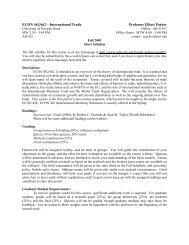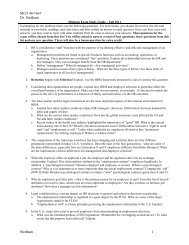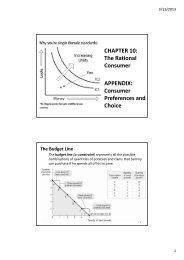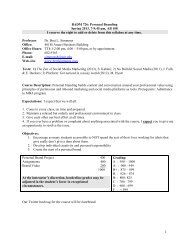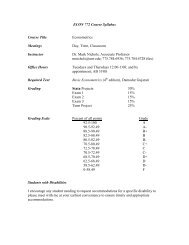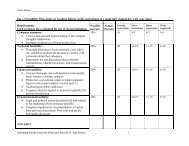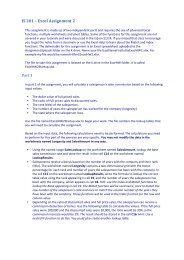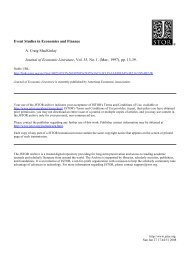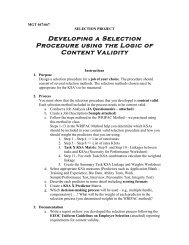Size Effect
Size Effect
Size Effect
You also want an ePaper? Increase the reach of your titles
YUMPU automatically turns print PDFs into web optimized ePapers that Google loves.
<strong>Size</strong> <strong>Effect</strong><br />
Collaborative Effort by:<br />
Brian T. Allman<br />
Patrick Hu<br />
Josh Jones<br />
Yann Ling-Barnes<br />
John Nunn
<strong>Size</strong> <strong>Effect</strong><br />
Outline<br />
•CAPM<br />
•EMH<br />
•Testing CAPM & EMH<br />
• Abnormal Returns in Small Firm Portfolios<br />
• Portfolio Strategies based on Market Capitalization<br />
•Results<br />
•Conclusion<br />
•Real-world Application
CAPM<br />
Capital Asset Pricing Model<br />
• All Expected Stock Returns are a function<br />
of:<br />
– Risk free borrowing Rate (R(<br />
f )<br />
– Riskiness of stock, as measured by Beta (B i )<br />
– Excess return on Market Portfolio [E(R[<br />
m )-R f ]<br />
E(R i ) = R f +B i [E(R m )-R f ]
CAPM<br />
Capital Asset Pricing Model<br />
• Holding the Market Risk Premium constant, each<br />
% increase of Risk should provide equivalent %<br />
increase in Return.<br />
[E(R m )-R f ] = ΔE(R<br />
)/ΔB i i<br />
• As Beta increases, Expected Return increases<br />
equivalently.
• Weak-Form EMH<br />
EMH<br />
Efficient Market Hypothesis<br />
– Prices on traded assets (stocks, bonds, or property)<br />
already reflect all past publicly available information.<br />
– Disproves Technical Analysis.<br />
WF EMH
EMH<br />
Efficient Market Hypothesis<br />
• Semi-Strong Strong Form EMH<br />
– Prices reflect all publicly available information and prices<br />
instantly change to reflect new public information.<br />
– Disproves Fundamental & Technical Analysis.<br />
S-SF EMH<br />
WF EMH
EMH<br />
Efficient Market Hypothesis<br />
• Strong Form EMH<br />
– Privately available information is instantly reflected<br />
within prices.<br />
– Disproves Insider Trading & Fundamental Technical<br />
Analysis.<br />
S-F EMH<br />
S-SF EMH<br />
WF EMH
• Purpose:<br />
Abnormal Returns in<br />
Small Firm Portfolios<br />
– To test the performance of small caps vs. large caps.<br />
– To test whether abnormal returns that are not explained<br />
by beta exist.
• The Test:<br />
Abnormal Returns in<br />
Small Firm Portfolios<br />
1. Collected NYSE & AMEX stock prices from 1962-1975.<br />
1975.<br />
• Daily returns<br />
• Common shares<br />
2. Ranked all stocks by market value and divided into 10<br />
equally-weighted portfolios.<br />
3. Beta estimates for the portfolios were close to 1.<br />
4. Combined daily returns to obtain portfolio returns.<br />
5. Re-balanced portfolio by repeating step 2 at the end of<br />
each year.<br />
6. Calculated abnormal returns.<br />
• Daily return of portfolio – Daily return of NYSE-AMEX index.
• Hypothesis:<br />
Abnormal Returns in<br />
Small Firm Portfolios<br />
– CAPM implies that any two assets with the same beta<br />
will have the same expected return.<br />
– Mean abnormal returns are zero.<br />
– According to CAPM, mean abnormal returns should be<br />
zero because all the portfolios have betas near one,<br />
which should approximate the return of the market as a<br />
whole.
Abnormal Returns in<br />
Small Firm Portfolios<br />
Results:<br />
– Portfolio with smallest firm on average experienced<br />
returns >20% a year higher than portfolio with largest<br />
firms.<br />
– Investors can form portfolios that systematically earn<br />
abnormal returns based on firm size.<br />
– Persistence of small firm abnormal returns reduces the<br />
chance that the results are due to market inefficiencies.<br />
– CAPM does not adequately describe stock return<br />
behavior.
• Purpose:<br />
Portfolio strategies based<br />
on market capitalization<br />
No matter how you slice it, small caps win out.<br />
– To determine if small firms, on average, earn higher<br />
rates of return than large firms.<br />
– To determine if actively managed portfolios out perform<br />
passively managed portfolios.
• The Test:<br />
Portfolio strategies based<br />
on market capitalization<br />
No matter how you slice it, small caps win out.<br />
– Collected NYSE & AMEX stock prices from 1963-1980.<br />
1980.<br />
• Daily returns<br />
• Common shares<br />
– Ranked all stocks by market value and divided into 10<br />
equally-weighted portfolios.<br />
– Active vs. Passive portfolio strategy.<br />
• Active – annual portfolio rebalancing<br />
• Passive – hold till 1980 without rebalancing<br />
• Placed any proceeds after delisting in an S&P 500 Index fund
Portfolio strategies based<br />
on market capitalization<br />
No matter how you slice it, small caps win out.<br />
• Investment Characteristics of The Market Value<br />
Portfolio<br />
Portfolio<br />
Average Annual<br />
Return<br />
Average Percent<br />
on AMEX<br />
Average Median<br />
Value ($M)<br />
Average Share<br />
Price<br />
Median Share<br />
Price<br />
Estimated<br />
Portfolio Beta<br />
MV1 32.77% 92.19% $92.19 $4.60 $5.24 1.58<br />
MV2 23.51% 77.33% $77.33 $10.80 $9.52 1.57<br />
MV3 22.98% 52.09% $52.09 $19.30 $12.89 1.50<br />
MV4 20.24% 34.05% $34.05 $30.70 $16.19 1.46<br />
MV5 19.08% 21.33% $21.33 $47.20 $19.22 1.43<br />
MV6 18.30% 12.73% $12.73 $74.20 $22.59 1.36<br />
MV7 15.64% 8.37% $8.37 $119.10 $26.44 1.28<br />
MV8 14.24% 4.73% $4.73 $209.70 $30.83 1.22<br />
MV9 13.00% 3.39% $3.39 $434.60 $34.43 1.11<br />
MV10 9.47% 2.25% $2.25 $1,102.60 $44.94 0.96
Portfolio strategies based<br />
on market capitalization<br />
No matter how you slice it, small caps win out.<br />
• Investment Characteristics of The Market Value<br />
Portfolio (cont’d)
• Results:<br />
Portfolio strategies based<br />
on market capitalization<br />
No matter how you slice it, small caps win out.<br />
Cumulative Increase, 1963‐1980<br />
Portfolio <strong>Size</strong> Active Strategy Passive Strategy Difference<br />
Smallest 4528% 1026% 3502%<br />
Largest 312% 328% ‐16%
• Results (cont’d):<br />
Portfolio strategies based<br />
on market capitalization<br />
No matter how you slice it, small caps win out.<br />
• Very small firms can generate large gains over long periods of<br />
time, even with passive strategy.<br />
• Small firms with
Portfolio strategies based<br />
on market capitalization<br />
• Transaction Cost:<br />
*Considering Transaction Costs<br />
– Estimated average of 950 stocks used per year,<br />
95 stocks per portfolio<br />
– Used Current costs of $10 per trade<br />
• Cumulative transaction costs:<br />
– $32,300 for actively managed portfolio<br />
– $1,900 for passively managed portfolio<br />
• Transaction costs in 1960’s s & 1970’s s >> today’s
CONCLUSION<br />
• What have we learned from these 2 papers?<br />
– Using a CAPM Market Risk Premium of 9% to compare a<br />
Large Cap Stock with a Small Cap Stock:<br />
– Reinganum disproved CAPM.<br />
– Small Cap stocks out perform Large Cap stocks even<br />
after additional Risk is considered.<br />
Portfolio Type: *Beta: E(R i<br />
) CAPM: *R i<br />
: Observed:<br />
Small Cap<br />
Portfolio<br />
Large Cap<br />
Portfolio<br />
1.58 16.22% 32.77%<br />
0.96 10.64% 9.47%
CONCLUSION<br />
• Reinganum disproved Semi-Strong Strong Form EMH.<br />
– Market Capitalization can be used to systematically<br />
construct a portfolio that out performs and generates<br />
consistent abnormal returns.<br />
S-SF EMH<br />
WF EMH
NEXT STEP<br />
• Real-World Application<br />
– Select security exchange<br />
• Nasdaq<br />
• NYSE<br />
– Determine firm size for inclusion<br />
– Fine tune portfolio criteria
NEXT STEP
NEXT STEP
NEXT STEP
NEXT STEP<br />
• Recent Returns of Small Cap Stocks<br />
– Total Returns from Morningstar Small Cap, Mid Cap &<br />
Large Cap Indexes<br />
YTD 1 Yr 3 Yr Avg 5 Yr Avg 10 Yr Avg<br />
Small Cap 6.50% 30.33% 10.16% 5.11% 8.23%<br />
Mid Cap 6.82% 28.35% 6.52% 4.67% 7.19%<br />
Large Cap 5.24% 18.83% 1.60% 2.63% 1.94%
<strong>Size</strong> <strong>Effect</strong><br />
QUESTIONS?




